Blog Archives
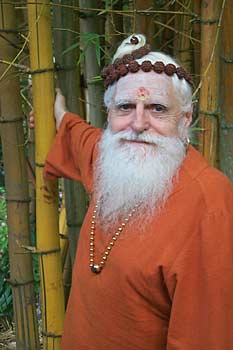
“Worship the One Supreme, Oh Mind!
That which pervades the universe and the soul–
‘Tis the Eternal Light of Reality.”
–Natchintanai. 175.
Our Beloved and Revered Satguru Sivaya Subramuniyaswami
Attained Maha Samadhi on November 12th, 2001
Click to read for Details.
Click here to read
Gurudeva’s statement on September 11th
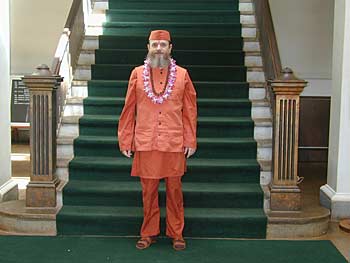
Bodhinatha at the county building in Lihue where he gave the opening blessing for the county council meeting.
Cybertalk: We received an invitation to give a blessing at the County Council meeting tomorrow. It’ll be Valentine’s Day. But what is Valentine’s Day to a Hindu monk? We can turn it into a Saivite holy day. Siva is our sweetheart, so he can be honored on this day. We can sing hymns of praise of Siva on Valentine’s Day. The Natchintanai “All is You” by Yogaswami is a wonderful hymn honoring Siva. Bodhinatha read this hymn aloud to all gathered in the temple.
Cybertalk Ends”
For more information about listening to Gurudeva’s talks online and to hear them in other formats, click here.
And click here for an Index to All Past CyberTalks.
Study Gurudeva’s teachings
every day. Visit the Master Course site!
Bodhinatha will be happy to hold “Prasnottara Satsang” — “Questions and Answers” over the telephone with any Hindu religious societies, Hindu youth groups, Radio talk show hosts etc. All you need is a phone with a speaker and an enthusiastic audience. Arrangements may be made in advance by sending email to Sadhaka Mahadevan
If you are experiencing any problems listening to the audio, please to go our Audio FAQ page for sound geeks and follow the directions there.
 |
|
|
 |
||
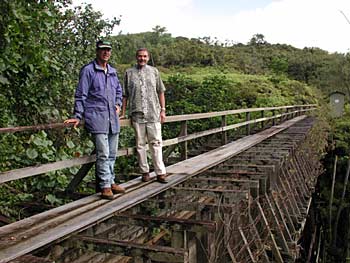
Deva Rajam with Les Milnes survey an old redwood “flume” of the East Kauai Water system. These old wooden “pipes” were used to transport water diverted from the river system to other irrigation areas in the section of Kauai “above” the monastery toward the mountains. Buiilt of redwood from California which has the special property of lasting for a long time if kept wet all the time. Our monks have taken a lead in helping create the East Kauai Water Cooperative to take over this valuable resource in the wake of the exodus of the sugar cane companies.

This is the precious resource that comes down to us from the heavens.

Conserving and putting the precious give of water to good use has been the work of kings and sages throughout the ages… Now in our era of democracy, the duty falls on the government and the local communities.

Deva Rajan speaks with Paramacharya Palaniswami before returning today to mainland USA.
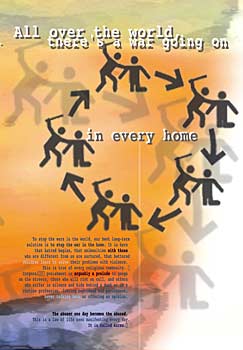
Speaking of various kinds of seva around the world by Gurudeva’s devotees, here is an innovative poster from Malaysia by Rohini Kumar in which he uses a modern design to put across Gurudeva’s message to “Stop the War in the Home.” Rohini runs a professional film, marketing, media and advertising design agency. He hopes to one day make a film of Gurudeva.
 The Remarkable Vision |
Iraivan Temple Progress Update |
Join this historic undertaking. Please contribute generously. Sponsor a stone today! |
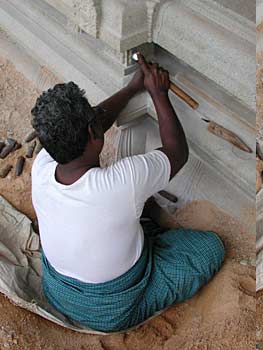
Work on the joining continues at our site here on Kauai.

Meanwhile the massive pillar symbols art project is underway. Over 200 drawings were done in a collaborative efforts with Sannyasin Natarajnathaswami and artist A. Manivelu in Chennai. Here the siplis uses charcoal sticks to transfer (by hand) the artword to the stone.
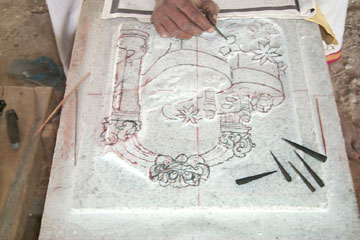
The markings indicate what portions of stone are to be removed and what remains in relief.
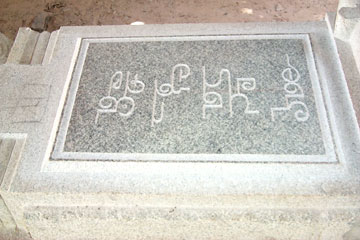
Iraivan will also carry some foundational Shum meditations called “the mamsane” which are used, one for each month of the year as a meditation guide. Here in four portraits lies the secret of Raja Yoga in the simplest of descriptions:
Kalebasa: “Samana” pranayama, where the breath count is the same in and out, nine counts inhalation and nine counts exhalation.
Vumtyaoode: this the shum for the blue, pingala current in the spine, the intellectual, agressive masculine force.
Kahrehaana: this is the shum for the red, ida current, the feminine, passive, earth current in the spine.
And at the bottom the last portrait is:
Nekashum: which is shum for “pratyahara” withdrawal of consciousness, on the breath, into the spine. The principle is to withdraw both ida and pingala into the spine…
This is a very simple and basic meditation preparation, but something which every meditator must do every time he or she sits down to meditate. Otherwise one will end up “stuck” in the thinking mind (pingala current predominately) or in the consciousness of the physical body (ida current predominating).
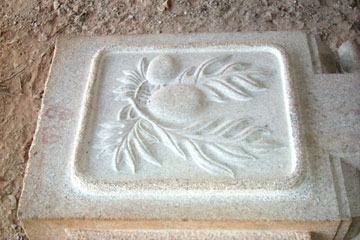
We are very impressed by the extent that the silpies have been able to take some intricate 2 dimensional line drawings and render them in stone… One day you too will touch these beautiful works when you come to Kauai. Please! Donate generously to the Iraivan temple project.
Gurudeva’s spiritual center in the island country of Mauritius
in the Indian Ocean near South Africa
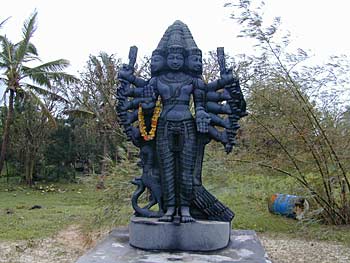
This is a unique photo of Lord Skanda at the far end of the Spiritual Park. Can you see the garland in Muruga’s hand? Well, it was offered to the deity by one dedicated devotee before the cyclone and was still there after the cyclone hit the island recently. Dina, an intense tropical cyclone did quite some damage over the whole island but its very strong gusts did not blow this garland away even one centimetre! Glory to Lord Skanda !
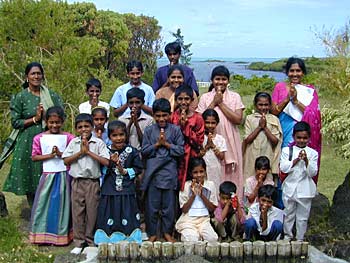
A new weekly Saivite Hindu religion class has started for the youth at the Saiva Dharmasala. The course covers three areas. The first is traditional Hindu philosophy based on the Vedas. The second is traditional culture and the third is character building and morals. A very happy group of motivated children are now attending this new course on every Saturday. On the very first day they learned some basic hatha yoga techniques and about how to always keep their spine straight. They studied about energy flowing within their body and many other wonderful things too.A team of experienced catalysts is nurturing these children. Here we see theyouth with two lady catalysts, Kulamata Premila and Kulamata Saramutha.
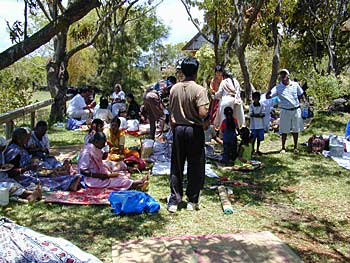
This Sunday we had a large bus packed with visitors from the centre of the island. They were from the Camp Fouquereaux Arya Mahila Samaj. Many of them came to the Park for the first time. Kulapati Manon and Kulapati Rajen gave them a description of the Spiritual Park. During their stay they worshipped at the Ganesha Mandapam and at the other shrines. At lunch time they all spread their mats to enjoy their vegetarian meals under the cool shade of the mango trees close to the Mandapam.
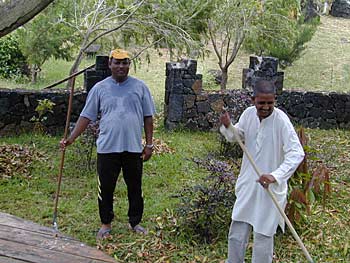
Everyone enjoys doing some hard work at the Dharmasala whenever they have the opportunity. The sishyas of Gurudeva specially have learned how karma yoga smoothens one’s karmas and develop humility in the individual. Here our two happy karma yogis, Vedapragassen Peruman on the right and Ravind Doorgiat from Riviere des Anguilles are raking dry leaves in the mango groves.

This wooden chest with a glass cover contains one of the vesthis which His Holiness Gurudeva Sivaya Subramuniyaswami has been wearing just before His Great Samadhi. One can feel the Guru’s Darshan when approaching it. This vesthi was given to Mauritius by the mathavasis after Gurudeva’s cremation. Kul. Manon Mardemootoo and his wife who attended the ceremony in Hawaii happily brought this precious cloth with them from Kauai Adheenam.
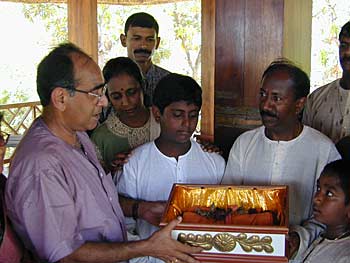
During a special humble ceremony inside the Ganesha Mandapam, Kulapati Manon explained to everyone present how the vesthi was given to Mauritian sishyas. Everyone had the opportunity to touch it before the wooden chest cover was sealed. Here we see Kulapati Manon ceremoniously handing over the chest to Kulapati Koothan thanking him for the good works he has been doing in Mauritius during Gurudeva’s transition period. This special chest is now being kept in a private shrine inside the Saiva Dharmasala.

|
Study Gurudeva’s teachings.
|
transcription begins
Date: February_13_2002
Title: To err is human…
Category: Self Improvement
Duration: 11 min., 37 seconds
Date Given: February 02, 2002
Given by: Bodhinatha
It came up last week in the communications with various sishya – the idea of making a mistake and how we react to a mistake that we make.
Of course, the common first reaction is to feel bad, to feel sad, to get emotional and wish we had not done it. Depending on how we were raised, that sadness can be small or large. If we were raised in a way to feel bad when we made mistakes, if that is what our parents emphasized, that blame and shame, “You made that mistake! You should never have done that. How could you be so stupid?” kind of approach, then of course, as an adult when we make a mistake we feel much worse than if we were not raised that way.
But in any case, that is a natural first reaction but we need to move beyond it. We cannot just stop there and end up feeling sad about it or extremely discouraged about it and leave the matter at that point.
I was thinking of a phrase, the one famous phrase, “To err is human but to forgive is divine.” Remember that phrase? So I have created a variation on the phrase, which is, “To err is human, but to err only once is divine.”
We all make mistakes. But if can make them only once, that is better than keeping on repeating the same mistake. We have that ability and someone who is self-reflective and focussed on what they are doing, the natural reaction after becoming sad, is to think about, “How can I prevent myself from doing this again? What did I do wrong? Was I simply careless? Am I lacking certain knowledge? Why is it that I did this in the first place?” That is someone who is really striving, not just kind of living in a fog of emotion or not really being mindful.
That is the objective, to find out what is missing. Perhaps we need some knowledge, perhaps there is something we did not learn about this subject, we need to know. Maybe we need to ask an expert or read a book. Maybe we just were not paying attention. We were thinking about one thing and doing another and that is why we made a mistake. We need to resolve to pay more attention next time we are doing this because there is certainly no reason we want to repeat the same mistake twice.
That is a necessary second reaction, stepping beyond just feeling bad – figuring out why it occurred and making sure it won’t occur again. That is being divine. To err only once is divine, when we are on the spiritual path, taking our mistakes seriously and striving not to make them twice.
However even a third step is needed if other people were involved. We may have upset them in some way by this mistake. We may have caused strained feelings, where feelings were flowing harmoniously before. If either of those situations have occurred then we need to fix the situation with the other person as the third step of having made this mistake. Perhaps an
apology would be appropriate. That is the most direct way to fixing something. But if we are not that close to someone, if they are a co-worker at work, an apology may seem out of place. So just extra friendly words or a gift or some kind action that we normally would not do is a way of fixing the flow of emotional force between us to get it back to a harmonious flow. If we made a mistake that hurt someone’s feelings, in that case help them let go of the hurt feelings towards us by the apology. That is the third step. Fixing emotional force, when a mistake occurs if other people are involved.
There is even a fourth step. This is reserved for serious mistakes. Let us say, in a weak moment we did something that was dishonest. Maybe we are a student who cheated slightly on a test or an adult who fudged on our tax return. We did something that was technically dishonest and afterwards we feel bad about it. Of course we resolve not to do it. In this case, no one else was involved. So we don’t have to apologize. We still feel bad about it. Well, what is needed? We need to do a penance. If after all the other corrections have been done to a mistake and we still feel bad, it means our conscience is telling us we did something that we really should not have. The way Gurudeva has taught us to compensate is we do a penance. Prostration penance of some kind but serious. Maybe we fly off to Fiji. Do a serious penance, depending on what it is. But in any case, as a result of the penance, any sense of feeling bad about it should be gone.
There is no reason we should feel bad about a mistake. We should get rid of that feeling, because we all make mistakes. It is natural to make mistakes. To err is human, so we need to accept that. That is how we learn. But when we do learn, we should feel good about having learned. We should not feel bad still. It is like in school. If we are studying mathematics and we don’t quite understand something and we get it wrong, we don’t feel that bad. We study a little harder and we get it right. Life is like that too. So the sense of feeling bad because of a mistake, should be gotten rid of one way or another.
These same principles regarding mistakes apply in the case of parent to child, teacher to student or supervisor to his or her staff. If a mistake is made, the elder person – the parent, the teacher, the supervisor – needs to help the younger person understand, gain new knowledge so that the person doesn’t make the mistake again. That is the whole goal, to not repeat the mistake.
Quite often, that is not the response that is given. The parent doesn’t sit down and figure out why the child made the mistake, take that amount of time and train the child, give the child new knowledge that the child is obviously lacking, so that the mistake isn’t made again. That doesn’t always happen. It is more likely to happen with a teacher because the teacher is paid to teach. The teacher knows the student made a mistake, maybe I didn’t do my job. Maybe there is something I need teach the child so the child won’t make the same mistake again.
So also, with a supervisor and staff. Depends on the situation, some are more prone to train than others. But if the supervisor has staff that makes a mistake, the first thought should be, “Is there something I need to train this staff in that they don’t know? Are they lacking knowledge?”
I had a wonderful conversation a couple of weeks ago with Iraja Sivadas. He is in Northern California taking care of his mother there. He is teaching at a school there for emotionally disturbed children. They have learning difficulties, growing up in difficult situations. It takes extra patience to teach them. So he is having a very interesting experience there dealing with these children. Quite often, the ones that have the most trouble learning are the ones that come from the most difficult family situations, where there is divorce at a very young age and so forth. So he has the personal history file of each student and he studies that in conjunction with teaching them. When difficulties come up, when they reject his teaching and give him a bad time, he tries to understand their personal history. So he finds that very helpful in terms of helping them acquire knowledge.
He has an interesting approach to Mathematics. He is so good at it that he doesn’t even need to follow the text book. He is an M.A. in Math. It is just second nature to him. It is like, a good music teacher doesn’t have to follow a music training book. He just knows how to teach music. He knows how to teach math and he has come up with a way of accommodating different people’s nature. He has found that he teaches each point in three different ways. He teaches three different ways to solve a specific kind of problem and one of the ways clicks with each student. He doesn’t know which way will work. But there are different ways people understand mathematics. Isn’t that interesting? So he presents it in three different ways and each student says, “Well of course, that way makes sense but the other two don’t. Why did you even bother to teach those?” But each student will choose one of the different three ways, not the same of course. So all three ways are necessary.
It shows he is a good teacher, that he has found an effective way to convey these principles to people based upon experience. So he is an excellent teacher of the subject and I am sure, students learn more about mathematics from him than from most mathematics teachers who just follow the text book in a simple way. He s taking that principle very seriously – “If someone makes a mistake, it means I need to pass on additional information to them that they don’t have so they won’t make the mistake twice.”
transcription ends
|
MORE UPLIFTING THINGS |
Innersearch 2002 in Hawaii!
Our next Innersearch Travel-Study program will be held right here on the island of Kauai in the summer of 2002. It’s the first such program on the Garden Island since 1974! From July 17 to July 22 we will enjoy daily classes with the swamis, join in the annual Guru Purnima festival, be inspired by local culture, explore the lush tropical island in exciting and non-touristy ways, and more. Be prepared for a wonderful spiritual experience in paradise with meditations, seminars and sacred ceremonies at the Siva temple of Kauai’s Hindu Monastery. Many have applied already, and there is a limit of 50 participants, so we recommend everyone apply as soon as possible. Interested? Please request an application from pilgrim@searchbeyond.com |
|

|
Check our children and youth section for new items for the young and young at heart! | |
|
1. SIGN OUR GUESTBOOK and receive a FREE GIFT |
||
| 2. Newest Book: LIVING WITH SIVA | ||
|
3. Visiting KAUAI’S HINDU MONASTERY |
||
|
4. Contribute to THANK YOU, GURUDEVA FUND |
||
From Our Gurus' Teachings
Archives are now available through 2001. Light colored days have no posts. 1998-2001 coming later.
